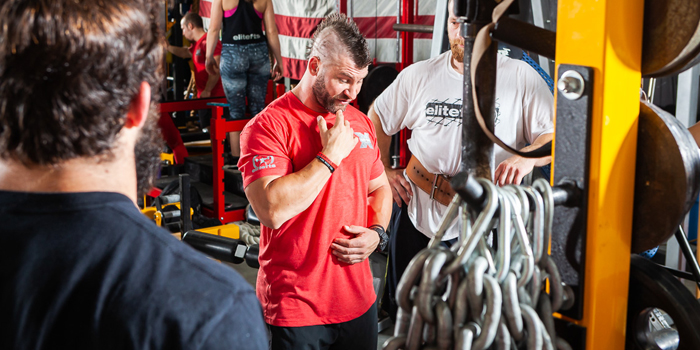
After roughly two and half years of having the idea of combining two training concepts, testing it on more than 50 people, and being badgered about the method in its entirety, I believe that it is time to write an article regarding “conjuphasic.” At one point, I was even told to write a book about it. It seemed like such a daunting task that I did not want to take it on, so this is the next best thing. I will do my best to describe this in its entirety over several article submissions. And because I am not the greatest author in the world, the concepts will hopefully be easy to follow and implement in your own training if you decide to use them.
Many mistakes were made over the first one and a half years of this program that was implemented on Julia and myself, and I made sure to pay the price prior to clients. Thus far, I have had 80 percent of people successfully increase their totals over multiple cycles of implementing this style of training. About 20 percent of individuals did not increase their totals; this statistic is based on one training cycle and not multiple cycles. Other factors were involved, but I am not here to make excuses and will assume the overall responsibility for this. These individuals did, however, feel better than they ever had going into a meet.
RECENT: How to Tell If Your Squat is Too Wide or Too Narrow
The Basics
Conjuphasic has been my attempt to mold the concept of “triphasic” training and the conjugate theory together. At its core, this training style is “conjugate.” If we want to split hairs, my training methodology is concurrent in nature, implementing block principles, as I do not like to stay focused on strength all of the time.
Let’s first look at triphasic principles from the book Triphasic Training by Cal Dietz:
- “All dynamic muscle action is triphasic!" This statement from Cal ties every sport together, allowing all athletes to be trained using the same method, and yielding the same results.
- Short explanation: The triphasic nature of all dynamic movement can be broken down into three phases.
- The eccentric phase involves the deceleration or lowering of weight movement. This is where muscle lengthening occurs. Kinetic energy is absorbed and stored in the tendons of the muscles to be used in stretch reflexes.
- The isometric phase is where the mass comes to a complete stop before reaccelerating in a new direction (governed by Sir Isaac Newton's laws of motion).
- The concentric phase is the acceleration of mass; it is associated with muscle shortening.
How this will be implemented for athletes on the field will differ from how it is implemented for powerlifting athletes, from what I have found. Implementing triphasic training with field athletes is paired with the French contrast method. I have found that this method does not work well for the average powerlifter, as these individuals are not field athletes, so certain qualities do not need to be trained. This is a completely different topic for an entirely different article with its own rabbit holes.
As I mentioned before, I attempted to pair this with the conjugate system. At its core, that is a concurrent style of training. I also prefer a block periodization structure, where I transition into this form of training coming out of a hypertrophy block. This molding of the two methods works perfectly for my methodology, as triphasic training rotates in blocks, complementing how I have already structured my athletes’ progressions. So, how does the pairing work? It’s hopefully pretty basic for everyone to see and/or understand. Remember, the triphasic principle applies mainly to the max effort days and max effort deadlifts during DOWN SETS or SECONDARY MOVEMENTS.
As of recently, I have added the triphasic principles to the repetition deadlift and NOT to the main max effort movement deadlifts. If you have any questions about that, feel free to email me. So, you will implement your max effort (ME) movements as normal on ME day. AFTER you complete this movement on LOWER days (squat and deadlift), you will drop the weight by 30 percent and do three sets of five reps with a FIVE-second negative during the eccentric phase. If you implement CHAINS in the main movement, attempt to keep all of the chains on. If the weight exceeds your ability to complete all three sets, drop TWO chains off. IF you use BANDS on the main movements, this can get complicated, and I urge beginners NOT to use bands. Always DOUBLE the bands. What this means is that the band goes on the bar first, then down to a peg or mounting point, THEN back up to the bar (four band strands visible). After you drop your weight percentage, ALSO DROP DOWN one color of your resistance band for down sets. What I mean by this is, if you use an elitefts monster mini band (thin green) on the main movements, your down set will use an elitefts mini band (thin red). When implementing down sets with triphasic principles on the bench press, MALES will drop the weight 25 percent, and FEMALES will drop the weight 20 percent. Adjustments to accommodating resistance stays the same as on lower body days and applies here as well.
During the ISOMETRIC PHASE, all percentage drops will be the same, but you will pause for three seconds at the bottom of the lift, for the squat and the bench, and at the mid-shin going down, on the deadlift. During the CONCENTRIC PHASE is when things get tricky; it can be implemented in several ways. The easiest way for all general lifters is doing this on the SQUAT drop percentages and ALL of the accommodative resistance per the above, in addition to adding reverse bands or wraps. For the bench press, go with dropping the weight percentage and accommodative resistance, then adding reverse bands or a slingshot. On the DEADLIFT, try dropping all accommodative resistance, and try NOT to use reverse bands or any assistance. The goal of this phase is to get up FAST, aka make the “up” portion of your lift as fast/explosive as possible. An example of an eccentric max effort day is as follows.
Use accessory variables for posterior chain development and trunk work:
Heavy Lower:
- Front Squats with SSB Backwards, Max 3: (ME Movement)
- Drop Weight 30% then 3x5 with a five-second negative: (Triphasic Implementation)
Heavy Lower Accessories:
- SSB Seated Round Back GoodMorning 3x8
- Single-leg DB RDLs 3x12
- Reverse Hypers 3x12
- Walking DB Carries, 3 trips
Stay tuned for the next installment of “Conjuphasic,” as I will talk about ME movements, how I choose sets and reps for accessories, decisions regarding using bands/chains with suggestions on setting them up, and how I will begin to maintain athletes’ “conditioning” through HIIT, recovery workouts, and de-loads. For any questions concerning “Part 1,” please message below in the comments section. If you want to see what an entire cycle of conjuphasic looks like, take a look at my training logs on elitefts, www.mohawkmethod.com, or check out my YouTube channel.











Sounds great thought!